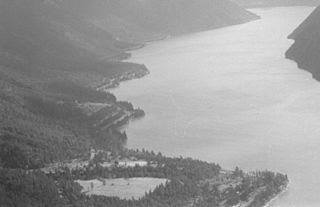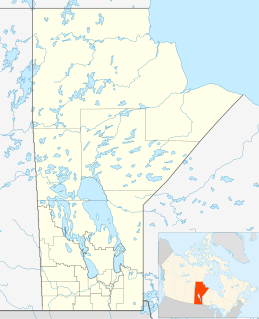
Mishkeegogamang First Nation No. 63, also known as New Osnaburgh, Osnaburgh House, or Osnaburgh for various settlements, or "Oz" for short, is a First Nation band government in the Canadian province of Ontario. Until 1993, the band was called the Osnaburgh First Nation.
Kwantlen First Nation is a First Nations band government in British Columbia, Canada, located primarily in Fort Langley. The Kwantlen traditionally speak the Downriver dialect of Halkomelem, one of the Salishan family of languages. As of June 2018, Kwantlen withdrew from the Sto:lo Tribal Council and currently operates as an independent Nation.

The Canoe Creek Band/Dog Creek Indian Band, also known as the Canoe Creek First Nation and/or Dog Creek First Nation is a First Nations government of the Secwepemc (Shuswap) Nation, located in the Fraser Canyon-Cariboo region of the Central Interior of the Canadian province of British Columbia. It was created when the government of the then-Colony of British Columbia established an Indian Reserve system in the 1860s. It is a member government of the Northern Shuswap Tribal Council.
The Alkali Lake Indian Band, also known as the Esketemc First Nation, is a First Nations government of the Secwepemc (Shuswap) people, located at Alkali Lake in the Cariboo region of the Central Interior of the Canadian province of British Columbia. It was created when the government of the then-Colony of British Columbia established an Indian Reserve system in the 1860s. It is one of three Secwepemc bands that is not a member of either the Shuswap Nation Tribal Council or the Northern Shuswap Tribal Council.

The Seton Lake First Nation, a.k.a. the Seton Lake Indian Band, is a First Nations government located in the Central Interior-Fraser Canyon region of the Canadian province of British Columbia. It is a member of the Lillooet Tribal Council, which is the largest grouping of band governments of the St'at'imc people. Other St'at'imc governments include the smaller In-SHUCK-ch Nation on the lower Lillooet River to the southwest, and the independent N'quatqua First Nation at the farther end of Anderson Lake from Seton Portage, which is the location of three of the band's reserve communities.
Wabaseemoong Independent Nations or more fully as the Wabaseemoong Independent Nations of One Man Lake, Swan Lake and Whitedog, is an Ojibway First Nation band government who reside 120 km northwest of Kenora, Ontario and 13 kilometres (8.1 mi) east of the Ontario-Manitoba border of northwestern Ontario, Canada. As of December, 2018, the First Nation had a population of 1,940 registered people, of which their on-Reserve population was 1000 registered members and approximately 100 non-Band members.

Census Division No. 16 is part of the Parklands Region of the province of Manitoba, Canada. The economy of the area is agriculture and livestock. The population of the region as of the 2006 census was 9,945. Also included in the division are the main reserves of the Gamblers First Nation, the Tootinaowaziibeeng First Nation, and the Waywayseecappo First Nation.
The Rural Municipality of Hillsburg is a former rural municipality (RM) in the Canadian province of Manitoba. It was originally incorporated as a rural municipality on November 19, 1912. It ceased on January 1, 2015 as a result of its provincially mandated amalgamation with the RM of Shell River and the Town of Roblin to form the Municipality of Hillsburg – Roblin – Shell River.

Alderville First Nation is a band of Mississaugas, a sub-nation of the Ojibways. The Alderville and Sugar Island 37A reserves belong to that First Nation band government.

Black Lake is a Denesuline First Nations band government in the boreal forest of northern Saskatchewan, Canada. It is located on the northwest shore of Black Lake where the Fond du Lac River leaves the lake to flow to Lake Athabasca.

The Katzie First Nation or Katzie Nation is the band government of the Katzie people of the Lower Fraser Valley region of British Columbia, Canada.
The Douglas First Nation, aka the Douglas Indian Band, Douglas Band, or Xa'xtsa First Nation, are a band government of the In-SHUCK-ch Nation, a subgroup of the larger St'at'imc people, also referred to as Lower Stl'atl'imx. The Douglas, Skatin and Samahquam communities are related through familial ties as well as culturally and linguistically. The In-SHUCK-ch are the southernmost of the four divisions making up the Lillooet ethnographic group. The Douglas First Nation's main community is at Xa'xtsa, a village on their main reserve at the head of Harrison Lake, near the former gold rush port-town of Port Douglas.

Marcel Colomb First Nation - (MCFN) Band #328 is a First Nations tribe aka Band, of approximately 417 Registered Rocky Cree people located in the area of Lynn Lake, Manitoba. Located within the reserve is a Water Treatment plant, 14 houses, Band Office and other infrastructure projects under development. The Black Sturgeon Falls Reserve locally referred to as Mile 21 or "the Promised Land", is located within the area of Hughes Lake - approximately 30 kilometres southeast of Lynn Lake.
The Tootinaowaziibeeng Treaty Reserve is a First Nation located 35 km east of Roblin, Manitoba, 74 km west of Dauphin, Manitoba, and approximately 5 km north of PTH #5. Tootinaowaziibeeng is a Treaty 4 First Nation.
Pinaymootang First Nation is a First Nations people whose home location is at Fairford, Manitoba on Fairford 50 Reserve. They are situated on Hwy #6 in the Interlake Region of Manitoba about 220 kilometres from Winnipeg. The Rural Municipality of Grahamdale forms most of the reserve's land boundary, although it also has a short border with the Little Saskatchewan First Nation as well as significant lakeshore on Lake St. Martin, which is considered as being outside the reserve. The main settlement on the reserve is located at 51°35′55″N98°41′32″W.
Treaty Four Reserve Grounds Indian Reserve No. 77 is an Indian Reserve in Saskatchewan, Canada, shared by 33 band governments from Saskatchewan and Manitoba. The Reserve Grounds are located adjacent to and west of Fort Qu'Appelle, Saskatchewan. All bands are signatories to Treaty 4. This Reserve may belong to Assiniboine Chief Long Lodge #77. Who was a treaty signatory chief to treaty 4 in 1877 at Cypress Hills
The West Region Tribal Council is a tribal council in Manitoba, which is a coordinating body for eight band governments representing c.9,000 members in total.
Gambler 63, officially Gambler Indian Reserve No. 63, is an Indian reserve in Manitoba, Canada, located 128 km northwest by north from Brandon, Manitoba. It is one of two reserves used by the Gambler First Nation, who also share Treaty Four Reserve Grounds Indian Reserve No. 77 near Fort Qu'Appelle, Saskatchewan with 23 other bands.
Shoal Lake Cree Nation is a First Nations band government in Saskatchewan, Canada located 98 kilometres (61 mi) east of Nipawin. The Cree First Nation is on the Carrot River and can be accessed by Highway 55. Nearby to the west is the Red Earth First Nation.









